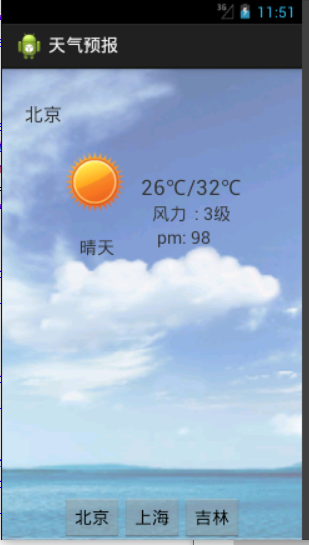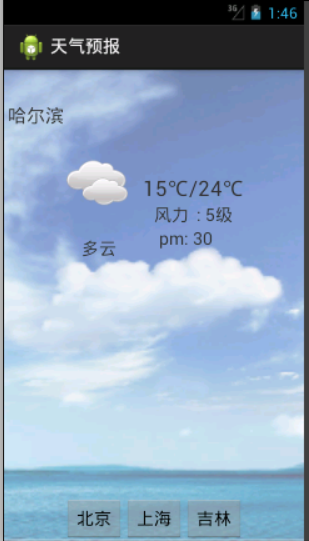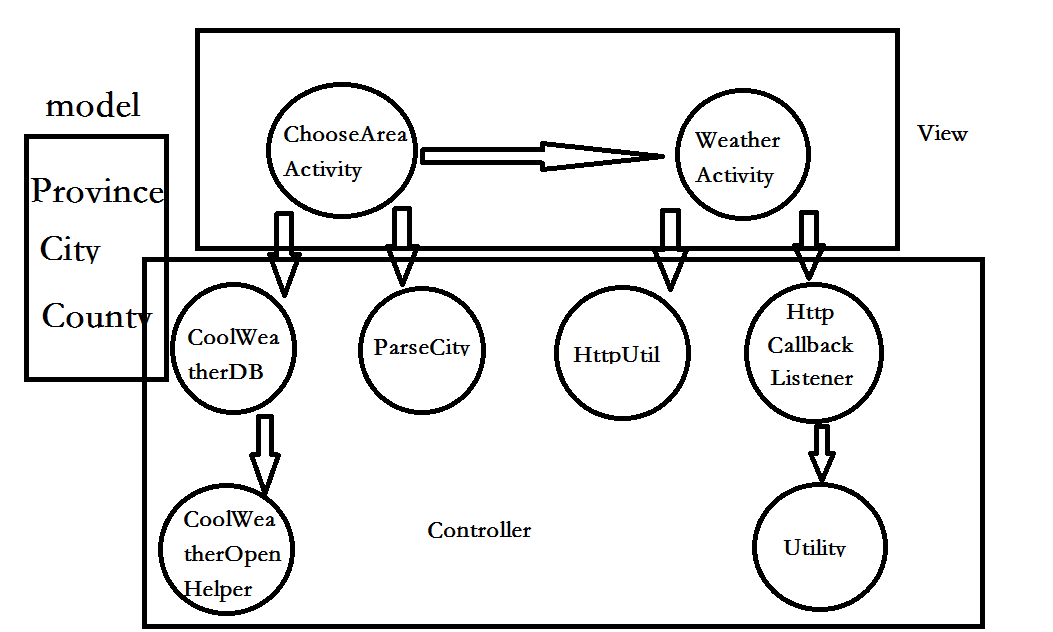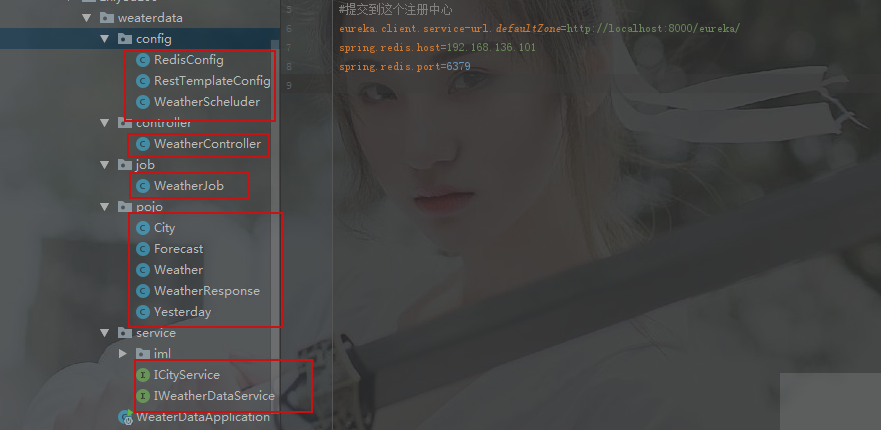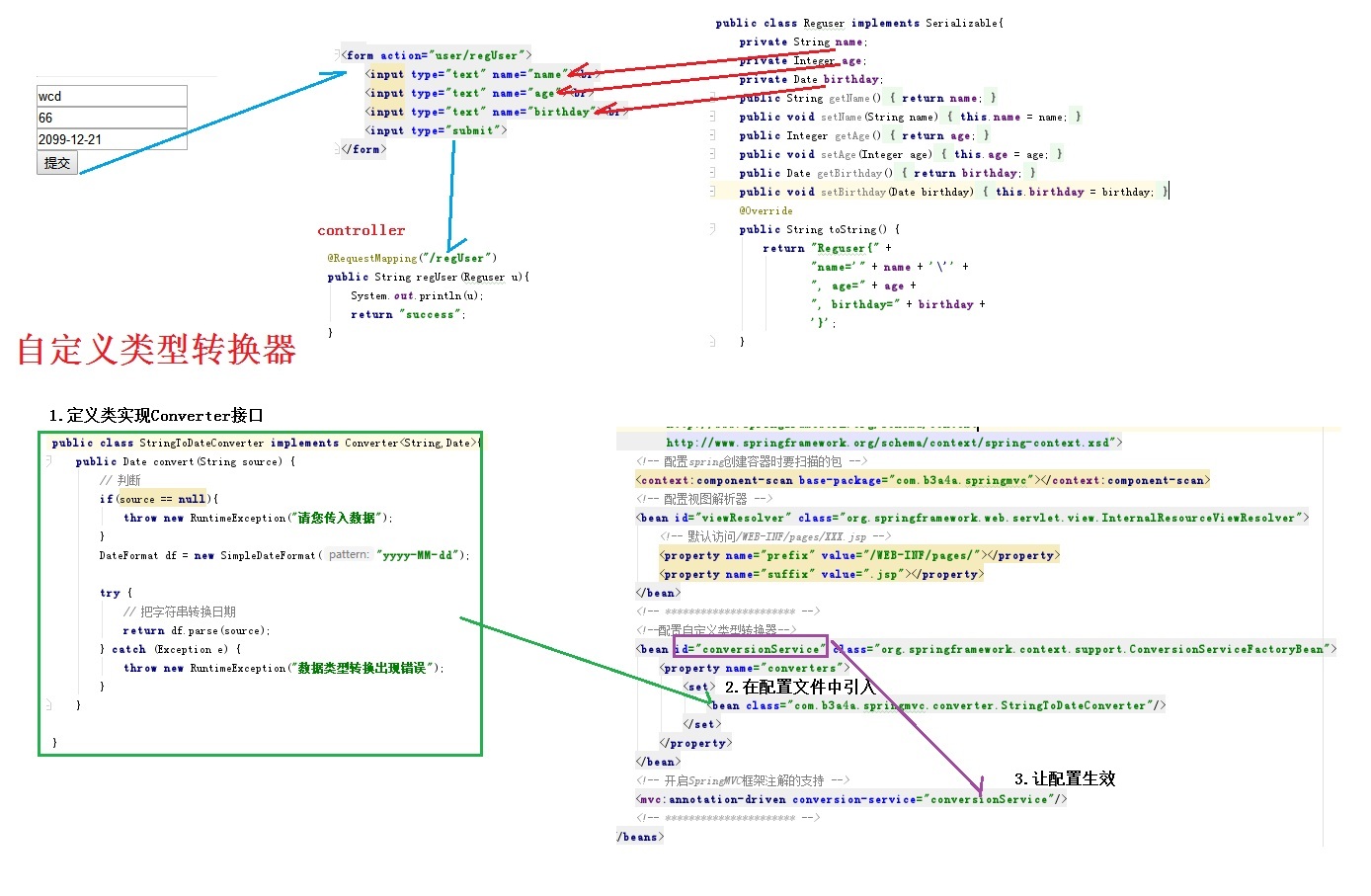Android學習筆記整理(12)--XML解析及天氣預報案例
標簽: XML解析 Android學習筆記 天氣預報案例 Android天氣預報
1.XML解析
若想要操作XML文檔,首先需要將XML文檔解析出來。通常情況下,解析XML文件有三種方式
- DOM解析
DOM(Document Object Mode)解析是一種基于對象的API,它會將XML文件的所有內容以文檔樹方式存放在內存中,然后允許使用DOM API遍歷XML樹、檢索所需的數據,這樣便能根據樹的結構以節點的形式來
DOM操作XML代碼看起來是比較直觀,編碼比SAX解析簡單,但DOM需要將整個XML文檔以文檔樹的形式存放在內存,消耗內存比較大。
- SAX解析
SAX解析會逐行掃描XML文檔,當遇到標簽時觸發解析處理器,采用事件處理方式解析XML。由于它是邊讀取邊解析,因此不存在內存占用的問題,可以解析超大XML。缺點是SAX解析只能讀取XML中的數據,無法進行增刪改
- PULL解析
PULL解析器是一個開源的Java項目,既可以用于Android應用,也可以用于JavaEE程序。Android已經集成了PULL解析器,所以在Android中最常用的解析方式是PULL解析。
使用PULL解析XML文檔,首先要創建XmlPullParser解析器,該解析器提供了很多屬性
XmlPullParser.START_DOCUMENT:XML文檔的開始
XmlPullParser.END_DUCUMENT:XML文檔的結束
XmlPullParser.START_TAG:開始節點,在XML文件中,帶<>的都是開始節點
XmlPullParser.END_TAG:結束節點,帶有</>都是結束節點
PULL解析器的用法:
(1)通過調用Xml.newPullParser();得到一個XmlPullParser對象
(2)通過parser.getEventType()獲取到當前的事件類型
(3)通過while循環判斷當前操作事件類型是否為文檔結束,是則跳出while循環
(4)while循環中通過switch語句判斷當前事件類型是否為開始標簽,是則獲取該標簽內容
2.案例--天氣預報(解析XML文件)
第一步,編寫主布局(activity_main.xml)
<RelativeLayout xmlns:android="http://schemas.android.com/apk/res/android"
xmlns:tools="http://schemas.android.com/tools"
android:layout_width="match_parent"
android:layout_height="match_parent"
android:background="@drawable/weather"
tools:context=".MainActivity" >
<LinearLayout
android:id="@+id/ll_btn"
android:layout_width="wrap_content"
android:layout_height="wrap_content"
android:layout_alignParentBottom="true"
android:layout_centerHorizontal="true"
android:orientation="horizontal" >
<Button
android:id="@+id/city_bj"
android:layout_width="wrap_content"
android:layout_height="wrap_content"
android:text="北京" />
<Button
android:id="@+id/city_sh"
android:layout_width="wrap_content"
android:layout_height="wrap_content"
android:text="上海" />
<Button
android:id="@+id/city_Harbin"
android:layout_width="wrap_content"
android:layout_height="wrap_content"
android:text="吉林" />
</LinearLayout>
<TextView
android:id="@+id/select_city"
android:layout_width="wrap_content"
android:layout_height="wrap_content"
android:layout_alignParentTop="true"
android:layout_marginTop="34dp"
android:layout_toLeftOf="@+id/icon"
android:text="上海"
android:textSize="20sp" />
<ImageView
android:id="@+id/icon"
android:layout_width="70dp"
android:layout_height="70dp"
android:layout_alignLeft="@+id/ll_btn"
android:layout_below="@+id/select_city"
android:layout_marginTop="25dp"
android:paddingBottom="5dp"
android:src="@drawable/ic_launcher" />
<TextView
android:id="@+id/select_weather"
android:layout_width="wrap_content"
android:layout_height="wrap_content"
android:layout_alignRight="@+id/icon"
android:layout_below="@+id/icon"
android:layout_marginRight="15dp"
android:layout_marginTop="18dp"
android:gravity="center"
android:text="多云"
android:textSize="18sp" />
<LinearLayout
android:id="@+id/linearLayout1"
android:layout_width="wrap_content"
android:layout_height="wrap_content"
android:layout_alignBottom="@+id/select_weather"
android:layout_alignRight="@+id/ll_btn"
android:layout_marginBottom="10dp"
android:gravity="center"
android:orientation="vertical" >
<TextView
android:id="@+id/temp"
android:layout_width="wrap_content"
android:layout_height="wrap_content"
android:layout_marginTop="10dp"
android:gravity="center_vertical"
android:text="-7℃"
android:textSize="22sp" />
<TextView
android:id="@+id/wind"
android:layout_width="wrap_content"
android:layout_height="wrap_content"
android:text="風力:3級"
android:textSize="18sp" />
<TextView
android:id="@+id/pm"
android:layout_width="73dp"
android:layout_height="wrap_content"
android:text="pm"
android:textSize="18sp" />
</LinearLayout>
</RelativeLayout>顯示效果如圖
第二步,創建weather,xml文件
在src根目錄中創建一個weather.xml文件,該文件包含三個城市的天氣信息
<?xml version="1.0" encoding="utf-8"?>
<infos>
<city id="1">
<temp>20℃/30℃</temp>
<weather>晴天多云</weather>
<name>上海</name>
<pm>80</pm>
<wind>1級</wind>
</city>
<city id="2">
<temp>26℃/32℃</temp>
<weather>晴天</weather>
<name>北京</name>
<pm>98</pm>
<wind>3級</wind>
</city>
<city id="3">
<temp>15℃/24℃</temp>
<weather>多云</weather>
<name>哈爾濱</name>
<pm>30</pm>
<wind>5級</wind>
</city>
</infos>
第三步,創建WeatherInfo類
每個城市天氣信息都包含id,temp,weather,name,pm和wind屬性
public class WeatherInfo {
private int id;
private String name;
private String weather;
private String temp;
private String pm;
private String wind;
public int getId() {
return id;
}
public void setId(int id) {
this.id = id;
}
public String getName() {
return name;
}
public void setName(String name) {
this.name = name;
}
public String getWeather() {
return weather;
}
public void setWeather(String weather) {
this.weather = weather;
}
public String getTemp() {
return temp;
}
public void setTemp(String temp) {
this.temp = temp;
}
public String getPm() {
return pm;
}
public void setPm(String pm) {
this.pm = pm;
}
public String getWind() {
return wind;
}
public void setWind(String wind) {
this.wind = wind;
}
}
第四步,創建WeatherService工具類
為了避免大量代碼都在一個類中,因此創建了一個的工具類,類中定義了一個getWeatherInfo()方法,用來解析XML文件
import java.io.InputStream;
import java.util.ArrayList;
import java.util.List;
import org.xmlpull.v1.XmlPullParser;
import android.util.Xml;
public class WeatherService {
//返回天氣信息的集合
public static List<WeatherInfo> getWeatherInfos(InputStream is)
throws Exception {
//得到pull解析器
XmlPullParser parser = Xml.newPullParser();
// 初始化解析器,第一個參數代表包含xml的數據
parser.setInput(is, "utf-8");
List<WeatherInfo> weatherInfos = null;
WeatherInfo weatherInfo = null;
//得到當前事件的類型
int type = parser.getEventType();
// END_DOCUMENT文檔結束標簽
while (type != XmlPullParser.END_DOCUMENT) {
switch (type) {
//一個節點的開始標簽
case XmlPullParser.START_TAG:
//解析到全局開始的標簽 infos 根節點
if("infos".equals(parser.getName())){
weatherInfos = new ArrayList<WeatherInfo>();
}else if("city".equals(parser.getName())){
weatherInfo = new WeatherInfo();
String idStr = parser.getAttributeValue(0);
weatherInfo.setId(Integer.parseInt(idStr));
}else if("temp".equals(parser.getName())){
//parset.nextText()得到該tag節點中的內容
String temp = parser.nextText();
weatherInfo.setTemp(temp);
}else if("weather".equals(parser.getName())){
String weather = parser.nextText();
weatherInfo.setWeather(weather);
}else if("name".equals(parser.getName())){
String name = parser.nextText();
weatherInfo.setName(name);
}else if("pm".equals(parser.getName())){
String pm = parser.nextText();
weatherInfo.setPm(pm);
}else if("wind".equals(parser.getName())){
String wind = parser.nextText();
weatherInfo.setWind(wind);
}
break;
//一個節點結束的標簽
case XmlPullParser.END_TAG:
//一個城市的信息處理完畢,city的結束標簽
if("city".equals(parser.getName())){
//一個城市的信息 已經處理完畢了.
weatherInfos.add(weatherInfo);
weatherInfo = null;
}
break;
}
//只要不解析到文檔末尾,就解析下一個條目。得到下一個節點的事件類型
//注意,這個一定不能忘,否則會成為死循環
type = parser.next();
}
return weatherInfos;
}
}
注意的是,type=parser.next()這行代碼不能忘記,因為在while循環中,當一個節點信息解析完畢,會繼續解析下一個節點,只有type的類型為END_DOCUMENT時才會結束循環。
第五步,編寫界面交互代碼(MainActivity類)
public class MainActivity extends Activity implements OnClickListener {
private TextView select_city, select_weather, select_temp, select_wind,select_pm;
private Map<String, String> map;
private List<Map<String, String>> list;
private String temp, weather, name, pm, wind;
private ImageView icon;
protected void onCreate(Bundle savedInstanceState) {
super.onCreate(savedInstanceState);
setContentView(R.layout.activity_main);
// 初始化文本控件
select_city = (TextView) findViewById(R.id.select_city);
select_weather = (TextView) findViewById(R.id.select_weather);
select_temp = (TextView) findViewById(R.id.temp);
select_wind = (TextView) findViewById(R.id.wind);
select_pm = (TextView) findViewById(R.id.pm);
icon = (ImageView) findViewById(R.id.icon);
findViewById(R.id.city_sh).setOnClickListener(this);
findViewById(R.id.city_bj).setOnClickListener(this);
findViewById(R.id.city_Harbin).setOnClickListener(this);
try {
// 調用上邊寫好的解析方法,weather.xml就在類的目錄下,使用類加載器進行加載
// infos就是每個城市的天氣信息集合,里邊有我們所需要的所有數據。
List<WeatherInfo> infos = WeatherService
.getWeatherInfos(MainActivity.class.getClassLoader()
.getResourceAsStream("weather.xml"));
// 循環讀取infos中的每一條數據
list = new ArrayList<Map<String, String>>();
for (WeatherInfo info : infos) {
map = new HashMap<String, String>();
map.put("temp", info.getTemp());
map.put("weather", info.getWeather());
map.put("name", info.getName());
map.put("pm", info.getPm());
map.put("wind", info.getWind());
list.add(map);
}
// 顯示天氣信息到文本控件中
} catch (Exception e) {
e.printStackTrace();
Toast.makeText(this, "解析信息失敗", 0).show();
}
getMap(1, R.drawable.sun);
}
@Override
public void onClick(View v) {
switch (v.getId()) {
case R.id.city_sh:
getMap(0, R.drawable.cloud_sun);
break;
case R.id.city_bj:
getMap(1, R.drawable.sun);
break;
case R.id.city_Harbin:
getMap(2, R.drawable.clouds);
break;
}
}
private void getMap(int number, int iconNumber) {
Map<String, String> bjMap = list.get(number);
temp = bjMap.get("temp");
weather = bjMap.get("weather");
name = bjMap.get("name");
pm = bjMap.get("pm");
wind = bjMap.get("wind");
select_city.setText(name);
select_weather.setText(weather);
select_temp.setText("" + temp);
select_wind.setText("風力 : " + wind);
select_pm.setText("pm: " + pm);
icon.setImageResource(iconNumber);
}
}第六步,運行程序查看天氣
運行當前程序,分別選擇,能看到圖中所示結果,代表著程序成功地解析了存儲在weather.xml文件中的天氣信息
智能推薦
android軟件開發--天氣預報
為什么80%的碼農都做不了架構師?>>> 這兩天開發了一個天氣預報軟件。基本上用到了很多之前學習的內容,然后發現,只有實踐,才能發現更加多的問題,也才能了解其中的原理,甚至可以辨別你以前的知識是否是正確。 本來我想把源碼發上來的,但是發現沒有添加附件的功能。只有通過代碼分享了。http://www....
空空天氣預報
之前寫了一款基于Android的空空天氣預報,能夠查看全國各個省、市、縣的未來三天的天氣預報,有穿衣指數和運動指數建議; 最近準備找工作了,現在重新回顧一下思路。 主要用到的知識有解析xml技術,解析json,mvc架構。 1、首先看下界面結果; 2、代碼思路 2-1 代碼架構圖 2-2 設計思路 2-2-1 首先解析一個省市縣xml文件,里面的代碼樣式如...
天氣預報部分
一、代碼 index.html sky.html index.css sky.css index.js 二、效果 三、注意知識點 1、get post 2、jsonp 3、ajax...
天氣預報項目
微服務搭建天氣預報項目 使用的技術 springboot、mybatis、mysql、quartz、springcloud等技術 首先是框架的搭建 父工程: 父工程只負責引入基本的依賴。 在創建服務注冊中心; 導入相關的依賴; 寫配置文件 服務中心創建完畢就該創建一個服務的提供者。 首先創建的是三級聯動動的城市服務。 導入相關的依賴 書寫配置文件 創建文件目錄 創建相關的類 pojo基本類 第一個...
猜你喜歡
freemarker + ItextRender 根據模板生成PDF文件
1. 制作模板 2. 獲取模板,并將所獲取的數據加載生成html文件 2. 生成PDF文件 其中由兩個地方需要注意,都是關于獲取文件路徑的問題,由于項目部署的時候是打包成jar包形式,所以在開發過程中時直接安照傳統的獲取方法沒有一點文件,但是當打包后部署,總是出錯。于是參考網上文章,先將文件讀出來到項目的臨時目錄下,然后再按正常方式加載該臨時文件; 還有一個問題至今沒有解決,就是關于生成PDF文件...
電腦空間不夠了?教你一個小秒招快速清理 Docker 占用的磁盤空間!
Docker 很占用空間,每當我們運行容器、拉取鏡像、部署應用、構建自己的鏡像時,我們的磁盤空間會被大量占用。 如果你也被這個問題所困擾,咱們就一起看一下 Docker 是如何使用磁盤空間的,以及如何回收。 docker 占用的空間可以通過下面的命令查看: TYPE 列出了docker 使用磁盤的 4 種類型: Images:所有鏡像占用的空間,包括拉取下來的鏡像,和本地構建的。 Con...
requests實現全自動PPT模板
http://www.1ppt.com/moban/ 可以免費的下載PPT模板,當然如果要人工一個個下,還是挺麻煩的,我們可以利用requests輕松下載 訪問這個主頁,我們可以看到下面的樣式 點每一個PPT模板的圖片,我們可以進入到詳細的信息頁面,翻到下面,我們可以看到對應的下載地址 點擊這個下載的按鈕,我們便可以下載對應的PPT壓縮包 那我們就開始做吧 首先,查看網頁的源代碼,我們可以看到每一...
